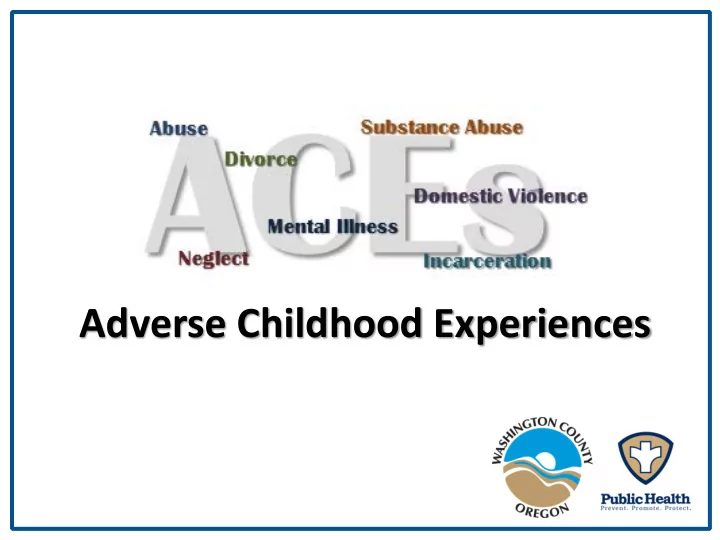

Adverse Childhood Experiences
What are ACEs?
The Adverse Childhood Experiences (ACE) Study • The largest study ever done that looks at the health and social effects of adverse childhood experiences over a lifespan.
The ACE Study Source: Centers for Disease Control and Prevention Credit: Robert Wood Johnson Foundation
The ACE Score Total number of categories of ACEs that each participant reported
Source: Robert Wood Johnson Foundation
BRFSS ACE Prevalence 2011 BRFSS ACEs in Oregon In Oregon, 64% 18% 0 ACEs reported one or 36% 1 ACE more ACEs 10% 2 ACEs 3 ACEs 4+ ACEs 13% 24% Data from Oregon Health Authority, 2011 & 2013
ACEs in Oregon 35% 30% 25% 20% 15% 10% 5% 0% Parents Household Parents Household Incarcerated Verbal Physical Violent Substance Separated or Mental Sexual Abuse Household Abuse Abuse Toward Each Abuse Divorced Illness Member Other Prevalence 31% 31% 31% 21% 20% 16% 14% 8% Data from Oregon Health Authority, 2011 & 2013
How Many Oregonian Children Have Been Exposed? Total number of ACEs % of NSCH Population Estimate respondents Zero ACEs 48.7% 413,489 One ACE 24.1% 204,865 Two or more ACEs 27.2% 230, 711 Data from National Survey of Children's Health, 2011/12
ACEs in Oregon Children National Oregon Adverse Childhood Experiences Prevalence Prevalence Child had one or more Adverse Child or Family Experiences 47.9 % 51.3 % Child had two or more Adverse Child or Family Experiences 22.6 % 27.2 % Socioeconomic hardship 25.7 % 28.8 % Divorce/separation of parent 20.1 % 23.0 % Death of parent 3.1 % 2.8 % Parent served time in jail 6.9 % 7.9 % Witness to domestic violence 7.3 % 7.4 % Victim or witness of neighborhood violence 8.6 % 8.3 % Lived with someone who was mentally ill or suicidal 8.6 % 13.5 % Lived with someone with alcohol/drug problem 10.7 % 16.8 %
Impact of ACEs on Children • We know that ACEs are linked to negative health outcomes in adulthood, but what about in children? • Children with ACEs are – More likely to: • Miss school days • Repeat grades – Less likely to: • Be engaged in school • Receive care in a medical home
The Impact of ACEs Across the Lifespan
Experiencing trauma during childhood is NOT a death sentence. We can help children and families in Washington County by: • Promoting awareness of ACEs • Providing safe, stable, nurturing relationships and environments • Becoming trauma-sensitive or providing trauma-informed services.
Washington County ACEs Initiative Will help build a foundation for healthier lives in Washington County by: Raising awareness of the life-long impact of childhood trauma • Mobilizing comprehensive responses to ACEs across the lifespan • Supporting efforts to build resilience in families and communities • Supporting efforts to create safe, stable, nurturing relationships and • environments (SSNRs) for children. Increasing efforts to integrate a trauma-informed approach into • practice, programs and policies.
Resources http://www.co.washington.or.us/HHS/ http://www.preventionlane.org/adverse-childhood-experiences-trauma http://cdc.gov/ace http://www.acestudy.org/ http://www.acestoohigh.com http://www.cdc.gov/brfss/index.htm http://www.cdc.gov/mmwr/preview/mmwrhtml/mm5949a1.htm http://www.oregon.gov/oha/Transformation-Center/Resources/ACEs-Brief-2014.pdf http://public.health.oregon.gov/HealthyPeopleFamilies/DataReports/Documents/OregonACEsReport.pdf http://www.rwjf.org/en/about-rwjf/newsroom/infographics/the-truth-about-aces.html http://www.childhealthdata.org For more information about the ACEs Initiative, please contact Octavia Chambers at octavia_chambers@co.washington.or.us or 503-846-3637
Recommend
More recommend